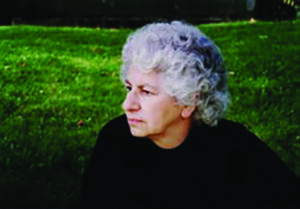 It is with deep sadness that we report the passing of illustrator Nonny Hogrogian on May 9, 2024, at the age of 92.
It is with deep sadness that we report the passing of illustrator Nonny Hogrogian on May 9, 2024, at the age of 92.
Hogrogian was born in New York City to parents born in Western Armenia. She earned her bachelor’s degree in fine arts from Hunter College in 1953. After graduating, Hogrogian worked as a book designer at Thomas Y. Crowell Col. In 1960, Crowell published her first works in the book King of the Kerry Fair by Nicolete Meredith, which Hogrogian illustrated with woodcuts. Subsequently, she worked as a designer at Holt and Scribner’s and as a freelance illustrator.
In 1971, Hogrogian married David Kherdian, a writer and editor. Together, they created over 30 illustrated children’s books, including Right Now, The Cat Who Loved to Sing and The Animal. Their works have been translated into numerous languages, including Spanish, Farsi and Western Armenian.
Hogrogian was awarded the Caldecott Medal for One Fine Day, an Armenian folktale, and Always Room For One More, a Scottish folktale by Sorche nic Leodhas. She was also awarded the Caldecott Honor Book Award for The Contest, an Armenian folktale.
In 2004, Hogrogian released her autobiography Finding My Name. The following are two excerpts from this intimately told memoir.
Sunday….
The hallway smelled sweet, like soap and cleanliness, with vacuuming that had sucked up two days’ worth of cooking odors.
While from the kitchen came the fresh aromas of the roasting lamb and apple pie.
The blue and white tiles glistened.
Momma was just emptying the bucket of soapy water into the sink and washing out her rags. There were small trickles running down the back of her neck and making dark spots on her dress.
“Zabel went to the Cushman’s to pick up the rolls,” she said. “Will you be an angel and tuck these things away so I can get myself cleaned and dressed before everyone gets here?”
“Sure, Momma.”
Daddy was scrubbed, shaved, and dressed by 7:00 o’clock, as he was every morning for work. Today he wore his best shirt and his dark maroon tie. He had finished reading the Sunday Times, and he was carrying in the extra leaves for the dining room table.
My grandmother was in the bedroom combing her silky white hair in long deliberate strokes. It was beautiful. She combed and combed, and then in the same rhythm she turned the tresses into a perfect knot at the nape of her neck. She tucked the silver hairpins around it to hold it in place. I noticed how shiny her round cheeks were with her hair combed straight back from her face.
She slipped into her tailored gray wool dress, buttoning each bone button with care. She buckled the narrow leather belt and turned to me to smile.
“In Erzingah,” she said, “my belts were made of solid gold, and they were this wide.” She showed me the width the span of her hand.
“Couldn’t you even bring one of them to America?”
“Yes, my sweet one,” she answered. “I did bring one…but that was a long time ago. Now we have a home instead…and now you and I had better set the table before everyone arrives. Come, Nonno jan.”
I could hear Poppa coming in from Church as we folded the lace tablecloth that Grandma had crocheted, and then tucked it into the buffet. Any minute now they would be here. The house was almost humming.
We carefully unfolded the damask tablecloth with the big shiny carnations on it. It was soft from many washings.
Our extended family came to our home for dinner every Saturday…
Music and art
Momma had the hardest time recovering from the deaths in our family. For some time she stayed out all afternoon, returning in time for the onslaught of company that arrived in the evenings.
But life seemed to slowly find its rhythm again. The family expected me to go to Hunter High School, like my sister had, but I didn’t have the perfect grades she had and I missed making it by a couple of points. I didn’t care. I really wanted to go to Music & Arts High School. I heard that was the place to go if one wanted to be an artist, and that was definitely what I wanted.
My father helped me pull together my few drawings and together we found a simple envelope to put them in for the interview and test. I took the bus to get there, and when I arrived, a shock set in. I was the only one there with a skimpy envelope of doodles and drawings. All the other young people had large black portfolios with prescribed art work in them. They had obviously been coached and had properly prepared for their exam.
Never mind, I thought, I know I’m a good artist. I will show them on the test. But I was shaking inside.
When we got to the testing room, the monitor announced that we were to do a contour drawing of the model sitting up front. I had never heard the word “contour” before and didn’t really understand.
The monitor explained. She said that this was a true test of our talent, training or not. We were to put our pencils on the paper and start to draw without looking at the paper — and with a single fluid line we were to capture the model on the paper.
My hand was tight. I began to draw. I felt myself make a tight little squiggle on the page. My eye looked down. Oh, no, I thought. I can do better than that. I would simply relax and turn the paper over. But I’d better ask for permission. I did. The monitor said, “I’m sorry, no,” and I felt as though my heart had broken. The tears rolled down my face even before I would let myself out of the room. I was sobbing uncontrollably by the time I got home. I had to wait for my mom, who was out again, and when she did come home, she made it seem as though it wasn’t important. I know she treated it lightly for my sake, but it wasn’t light. It was a very big deal for me. Underneath the upset, there was a growing outrage from their saying that this was a test of talent. I know I had talent. I would prove them wrong.
That summer, the four of us took a trip across the country to visit family in California. My sister and I sat in the back of the car, where Zabel, who often got carsick, spent most of the trip sleeping. I sat in my corner with my feet on the back of the front seat, and with a sketch pad on my lap. I drew my feet in many, many different positions, and all in contour technique. I became an expert contour artist and anyone who says it takes no training is mistaken. No training by a teacher, perhaps, but freedom of the wrist and hand and plenty of practice. The test brought out the stubborn streak in me, and a determination to prove them wrong. What I understood, that they seemed to have missed, was that although a person may have an innate ability, inherited or otherwise, to do anything well takes a strong wish, hard work, and perseverance.



Nonny was a brilliant artist and writer and a wonderful person. There can be no replacing such an amazing woman. But we are fortunate to have her incredible work which will live on and on.
I enjoyed her book,”Rooster Brother”,
a fine Armenian folk tale, I have used with my fourth grade students.